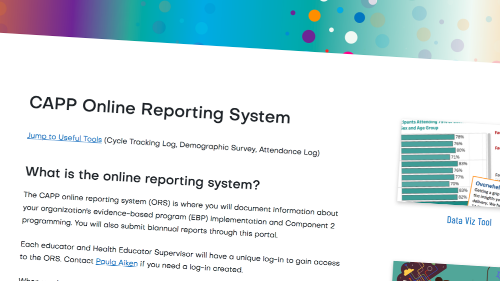CAPP: Reducing the Risk
Reducing the Risk (RTR) is a 16-session curriculum designed to help high school students delay the initiation of sex or increase the use of protection against pregnancy and sexually transmitted infections (STI) if they choose to have sex. The program gives teens the information, skills, and confidence to protect themselves from unplanned pregnancy, HIV, and other STIs. It empowers young people to change their behaviors and lower their risks by abstaining from sex or by using latex condoms if they choose to have sex. The program's major focus is the development of attitudes and skills that will help teens prevent pregnancy and the transmission of STIs, including HIV. This research-proven approach addresses skills such as risk assessment, communication, decision making, planning, refusal strategies, and delay tactics.
Evidence of Effectiveness
RTR has been extensively evaluated over the last several decades. Initial evaluations (e.g., Kirby et al., 1991; Barth, 1992) demonstrated moderate effects showing a positive impact on contraceptive use. Both Zimmerman et al (2008) and Reyna and Mills (2014) found that program participants delayed sexual initiation. Although some later studies did not replicate these findings (e.g., Abt Associates, 2015, Kelsey et al., 2016), Cunningham et al (2016) did find positive impacts on sexual initiation and contraceptive use. For a full review of the evidence see:
Curriculum Objectives
The RTR curriculum is available for purchase from ETR.
As a result of participating in RTR, students will be able to:
- Evaluate the risks and lasting consequences of becoming an adolescent parent or becoming infected with HIV or another STI.
- Recognize that abstaining from sexual activity or using contraception/condoms are the only ways to avoid pregnancy, HIV, and other STIs.
- Conclude that factual information about contraception and protection is essential for avoiding teen pregnancy, HIV, and other STIs.
- Demonstrate effective communication skills for remaining abstinent and for avoiding unprotected sexual intercourse.
Implementing Reducing the Risk
RTR can be implemented with high school students in both rural and urban areas. It has been used successfully with students from a range of racial/ethnic backgrounds. While designed primarily for ninth grade students, it can be used with students in other appropriate grades (e.g., 8-12) or the appropriate age (e.g., 13-18).
The curriculum is delivered through role-plays, skill practice, brainstorming, mini-lecture, and worksheet activities. Role-plays are an essential and powerful part of the program. At first, students may be hesitant about their performances, but many begin to enjoy these opportunities. Educators help students by encouraging them to practice their interpersonal skills in the role-plays. The more students practice effectively saying no to sex (or to unprotected sex), the more likely they are to use these skills in real life.
Implementation guidelines make clear the program developer's recommendations as well adaptations you may need to consider. Take these guidelines into account as you plan for implementation.

Important Reminders
Pre-Post Surveys
Remember, pre-post surveys are required for each evidence-based program you implement. Learn more:
Educator Training
Prior to facilitating the program, educators must complete the Training of Educators for BPBR and the online implementation training offered by ACT for Youth. Scheduled trainings are posted on the CAPP Training Calendar:
Documentation
All adaptations — planned and unplanned — must be recorded in the online reporting system.
Adaptations
While some adaptations will render a program ineffective (for example, turning a skill-building activity into a lecture), others are necessary (updating language to make a program more inclusive of specific populations, for example). Whenever possible, necessary adaptations should be planned in advance, working with ACT for Youth.
Planning Tool: Master Lists
To help you plan, implement, and report adaptations systematically, ACT for Youth has developed planning tools for master lists of adaptations for each EBP. Health Educator Supervisors can use these tools to draft a master list. Below, we've provided a Be Proud! Be Responsible! (BPBR) master list as an example. Your ACT for Youth Support Team will work with you to finalize your own adaptation master list.
On Site: Adaptation Notes Tool
When adaptations happen on the fly, they must be recorded. All data on adaptations can help us understand how to improve program implementation. To facilitate note-taking, the document below has a notes section for each activity.





